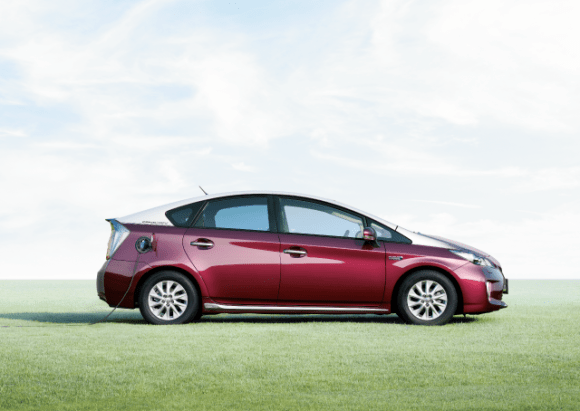
Toyota’s Prius is designed for one purpose, and it’s not to deliver the sort of exciting performance that will seduce you into taking a spirited drive through a moonlit mountain pass (that’s another car’s job). No, the Prius promise is that it will get you from Point A to Point B in the most energy-efficient way possible.
But while the standard hybrid Prius remains a popular choice for eco-conscious motorists, sales of its plug-in variant have been stagnant. Toyota is hoping to change that, though, with an updated Prius that can travel roughly twice as far under purely electric power than the current model.
If you’re the kind of person who’s more familiar with the handling differences between front-wheel, rear-wheel, and all-wheel drive than what separates one class of hybrid from another, a brief refresher on just what constitutes a plug-in hybrid may be in order. Unlike a standard hybrid vehicle, the batteries in a plug-in hybrid can be charged directly by plugging the car into a socket. By allowing the car to run in either a purely electric mode or with the electric motor and gas engine working together, plug-in hybrids seek to combine the flexibility of a normal hybrid with the efficiency and lower emissions of an all-electric vehicle.
Toyota released its first plug-in Prius, called the Prius PHV, in January of 2012. Hoping to build on the strong brand awareness and reputation of the normal hybrid Prius, the company was expecting a similarly warm response for the newer, ostensibly more advanced version of the car.
But while the Prius PHV sought to offer the advantages of both a hybrid and all-electric mode, it couldn’t deliver on the latter for very long. From a full charge, the current Prius PHV can only run 26.4 kilometers (16.4 miles) in full-electric mode before its batteries are drained, meaning that unless you’re headed someplace fairly close, you’re going to need to burn a little gas to get there and back.
Car buyers haven’t seen that as much of an advantage, especially considering that prices for the Prius PHV start at 2,931,429 yen (US$24,634), more than 30 percent more than the ordinary Prius hybrid, which is priced from 2,232,000 yen. The end result is lackluster sales numbers, and three years and three months after its launch, Toyota has only found some 20,000 buyers for the Prius PHV, a mere fifth of what the company was hoping for in that time frame.
In contrast, rival Mitsubishi Motors has enjoyed great success with its Outlander PHEV plug-in hybrid SUV, which boasts a 60.2-kilometer all-electric range. Even with its much higher price (starting at 4,123,440 yen), Mitsubishi has been selling Outlander PHEVs at a brisk pace, moving 13,000 in 2015 alone.
This sales gap has shown Toyota that it needs to step up its game, and the company has announced that the Prius PHV will be getting an update. Equipped with an increased quantity of batteries, and also thanks to weight-saving measures in other parts of the vehicle, Toyota is promising that the refreshed Prius PHV will be able to travel more than 50 kilometers in its all-electric mode, a distance roughly twice what the current model is capable of.
The new Prius PHV is expected to arrive at dealers in the fall of 2016. In the meantime, grab a map and start plotting out all the new places you’ll be able to go without needing a drop of gas.
Source: Tokyo Shimbun
Top image: Toyota (edited by RocketNews24)
Insert images: Toyota, Mitsubishi Motors (edited by RocketNews24)



 New king of hybrids: Honda’s new Fit Hybrid to boast a 85.6 mpg fuel efficiency level
New king of hybrids: Honda’s new Fit Hybrid to boast a 85.6 mpg fuel efficiency level Toyota shifts otaku marketing into high gear with Vocaloid song, cosplay of car part girls 【Vids】
Toyota shifts otaku marketing into high gear with Vocaloid song, cosplay of car part girls 【Vids】 New smartphone game turns car models into anime girls with model-worthy looks
New smartphone game turns car models into anime girls with model-worthy looks That time Seiji called JASRAC to ask why he didn’t get paid royalties for his song being on TV
That time Seiji called JASRAC to ask why he didn’t get paid royalties for his song being on TV The best Starbucks Japan Frappuccinos we want to drink again in 2026
The best Starbucks Japan Frappuccinos we want to drink again in 2026 Hayao Miyazaki says Happy New Year to Studio Ghibli fans with new art for Year of the Horse
Hayao Miyazaki says Happy New Year to Studio Ghibli fans with new art for Year of the Horse Mikado Coffee is a 76-year-old coffee chain with a major celebrity connection
Mikado Coffee is a 76-year-old coffee chain with a major celebrity connection Pizza Hut Japan’s hot lucky bags are perfect for a New Year’s pizza party
Pizza Hut Japan’s hot lucky bags are perfect for a New Year’s pizza party Japanese men list seven traits that would make it impossible for them to date a woman
Japanese men list seven traits that would make it impossible for them to date a woman Senkoji: The Japanese temple that’s more like a theme park to heaven and hell
Senkoji: The Japanese temple that’s more like a theme park to heaven and hell Brand-new Cardcaptor Sakura Cafe opens in Tokyo this week, with Kero-chan calling the shots
Brand-new Cardcaptor Sakura Cafe opens in Tokyo this week, with Kero-chan calling the shots Starbucks Japan’s new sakura collection arrives in stores for hanami season 2024
Starbucks Japan’s new sakura collection arrives in stores for hanami season 2024 Toyokazu Nagano’s “Magic Road” – the funniest, most adorable photos you’ll see today
Toyokazu Nagano’s “Magic Road” – the funniest, most adorable photos you’ll see today Starbucks Japan ready to get Year of the Horse started with adorable drinkware and plushies【Pics】
Starbucks Japan ready to get Year of the Horse started with adorable drinkware and plushies【Pics】 Cyberpunk anime meets traditional culture in Ghost in the Shell gold leaf Japanese changing screens
Cyberpunk anime meets traditional culture in Ghost in the Shell gold leaf Japanese changing screens 7 great places to see Mt. Fuji from without having to climb it
7 great places to see Mt. Fuji from without having to climb it Hello Kitty Choco Egg figures are an adorable trip through three periods of Japanese pop culture【Pics】
Hello Kitty Choco Egg figures are an adorable trip through three periods of Japanese pop culture【Pics】 7-Eleven Japan’s ramen-cooking robot whipped us up a bowl of noodles【Taste test】
7-Eleven Japan’s ramen-cooking robot whipped us up a bowl of noodles【Taste test】 We found possibly the quietest Japanese-style hotel in Tokyo’s bustling Shinjuku district
We found possibly the quietest Japanese-style hotel in Tokyo’s bustling Shinjuku district Japan’s otoshidama tradition of giving kids money at New Year’s gets a social welfare upgrade
Japan’s otoshidama tradition of giving kids money at New Year’s gets a social welfare upgrade Sumo Sanrio! Hello Kitty and pals team up with Japan Sumo Association for new merch【Pics】
Sumo Sanrio! Hello Kitty and pals team up with Japan Sumo Association for new merch【Pics】 More Than a Capsule Stay: Why Solo Travelers Choose “global cabin Yokohama Chinatown”
More Than a Capsule Stay: Why Solo Travelers Choose “global cabin Yokohama Chinatown” Japan’s oldest largetooth sawfish in captivity back on display in Mie Prefecture
Japan’s oldest largetooth sawfish in captivity back on display in Mie Prefecture 7-Eleven Japan starts new temporary luggage storage service in over 300 branches
7-Eleven Japan starts new temporary luggage storage service in over 300 branches Disillusionment at Tsukiji’s tourist-target prices led us to a great ramen restaurant in Tokyo
Disillusionment at Tsukiji’s tourist-target prices led us to a great ramen restaurant in Tokyo Starbucks teams up with 166-year-old Kyoto doll maker for Year of the Horse decorations【Photos】
Starbucks teams up with 166-year-old Kyoto doll maker for Year of the Horse decorations【Photos】 Tokyo considering law requiring more trash cans following litter increase in heavily touristed area
Tokyo considering law requiring more trash cans following litter increase in heavily touristed area Tokyo’s Tsukiji sushi neighborhood asks tour groups to stay away for the rest of the month
Tokyo’s Tsukiji sushi neighborhood asks tour groups to stay away for the rest of the month Tokyo event lets you travel back in time, for free, to celebrate 100 years since Showa era start
Tokyo event lets you travel back in time, for free, to celebrate 100 years since Showa era start Sanrio theme park in Japan announces plans to expand into a Sanrio resort
Sanrio theme park in Japan announces plans to expand into a Sanrio resort Japan may add Japanese language proficiency, lifestyle classes to permanent foreign resident requirements
Japan may add Japanese language proficiency, lifestyle classes to permanent foreign resident requirements Stamina-destroying “Paralysis Noodles” are Tokyo’s newest over-the-top ramen innovation
Stamina-destroying “Paralysis Noodles” are Tokyo’s newest over-the-top ramen innovation Survey asks foreign tourists what bothered them in Japan, more than half gave same answer
Survey asks foreign tourists what bothered them in Japan, more than half gave same answer Japan’s human washing machines will go on sale to general public, demos to be held in Tokyo
Japan’s human washing machines will go on sale to general public, demos to be held in Tokyo Japan’s deadliest food claims more victims, but why do people keep eating it for New Year’s?
Japan’s deadliest food claims more victims, but why do people keep eating it for New Year’s? We deeply regret going into this tunnel on our walk in the mountains of Japan
We deeply regret going into this tunnel on our walk in the mountains of Japan Studio Ghibli releases Kodama forest spirits from Princess Mononoke to light up your home
Studio Ghibli releases Kodama forest spirits from Princess Mononoke to light up your home Major Japanese hotel chain says reservations via overseas booking sites may not be valid
Major Japanese hotel chain says reservations via overseas booking sites may not be valid Put sesame oil in your coffee? Japanese maker says it’s the best way to start your day【Taste test】
Put sesame oil in your coffee? Japanese maker says it’s the best way to start your day【Taste test】 No more using real katana for tourism activities, Japan’s National Police Agency says
No more using real katana for tourism activities, Japan’s National Police Agency says Starbucks Japan reveals new sakura drinkware collection, inspired by evening cherry blossoms
Starbucks Japan reveals new sakura drinkware collection, inspired by evening cherry blossoms Updated cherry blossom forecast shows extra-long sakura season for Japan this year
Updated cherry blossom forecast shows extra-long sakura season for Japan this year Japanese researchers redesign electric car to go farther than ever before on a single charge
Japanese researchers redesign electric car to go farther than ever before on a single charge Beautiful models and cool cars from the Japan Mobility Show【Photos】
Beautiful models and cool cars from the Japan Mobility Show【Photos】 Hugh Jackman stars, sings J-pop cover, and speaks Japanese in ads for Toyota【Videos】
Hugh Jackman stars, sings J-pop cover, and speaks Japanese in ads for Toyota【Videos】 Tokyo Motor Show 2013: Cars! Crowds! Comely models! 【Photos】
Tokyo Motor Show 2013: Cars! Crowds! Comely models! 【Photos】
Leave a Reply